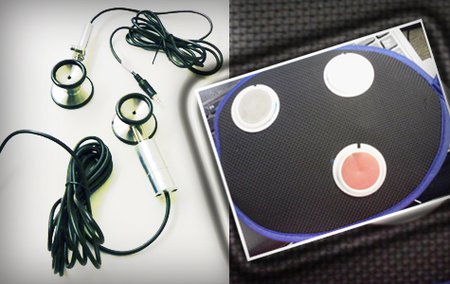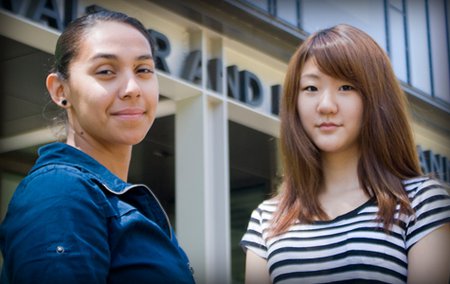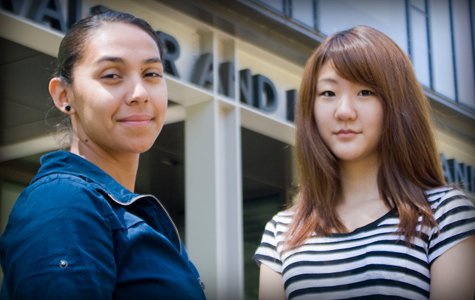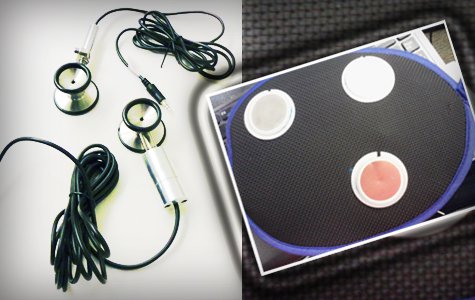SURFers Develop Cell-Phone Medical Devices
Over the coming weeks, we’ll be highlighting several undergraduates and their summer research at Caltech. Some are Techers; others hail from schools across the country. Most are participating in the Summer Undergraduate Research Fellowships (SURF) program, a unique opportunity for undergraduates to spend 10 weeks over the summer doing original research with Caltech faculty. At the end of the project, students write a paper and present their work at SURF Seminar Day, which will take place on October 15 this year.
One looks like little more than a stethoscope head attached to a wire; the other seems to be an oven mitt with three metal disks sewn on. Simple, yes, but these prototype medical devices—developed by young Caltech researchers working on a SURF project—could one day save lives.
Four undergrads have spent the summer developing and refining the prototypes as part of the cell-phone medicine project, headed by Julian Bunn of the Center for Advanced Computing Research (CACR) and Mani Chandy, Simon Ramo Professor and professor of computer science at Caltech. The lofty long-term goal of the project? To make the "10-cent medical checkup" a reality.
In some parts of the world, such as in India, people are much more likely to have a cell phone than to have convenient access to a physician. After all, medical clinics can easily be more than a day away from remote locations, and many laborers in such locations often can't afford to miss even a single day's wages—all of which makes medical visits nearly impossible.
"We want to exploit cell-phone technology and the Internet to provide inexpensive health-care tests for the poor in remote rural villages," says Chandy.
To that end, the team of undergrads is building a collection of medical devices that can be connected to a cell phone—an Android phone, at the moment—to conduct simple medical tests, such as blood pressure checks, temperature readings, and heart monitoring. Eventually, the idea is to build software that could analyze data from these tests and sort results into one of two categories: "probably normal" or "refer to doctor." Referred results would upload to an Internet cloud, where doctors from virtually anywhere could look at the data and determine if a patient should go to a clinic for further analysis.
The wired stethoscope and oven mitt are the prototypes of devices designed to be plugged into cell phones. The stethoscope has a microphone and electronics housed within a custom-made aluminum case. Incorporated within the mitt are three piezoelectric sensors. The user can simply slip on the mitt and hold it up to his or her heart to record both heart rhythms and the electrical signals that make up an electrocardiogram (ECG).
The prototypes were built by seniors Alex Fandrianto, Theresa Juarez, and Albert Tan, and junior EunJee Lee. They didn't start from scratch—this is the third summer that SURF students have worked on this project—but they started the project a bit under the gun: a collaborating team from UC Irvine that had offered to take some of the team's prototypes to India for testing was leaving just three weeks into the program. The Techers met the challenge, and the UCI group is now collecting real data from three of the wired stethoscopes and will soon be using one of the ECG gloves.
Still, plenty of work remains for the SURFers. Fandrianto, a computer science major, is enhancing the software that handles recorded data and uploads it to the Internet. He's also working on software filters to improve the signal-to-noise ratio of the heart-rhythm recordings.
"This is a real-world problem," Fandrianto says. "It's nice to feel like you're having a global impact with your research."
Tan and Lee, both electrical engineering students, are working on ways to improve the ECG device. The first prototype was not able to record stethoscope and ECG data simultaneously, which is a problem because physicians need to see both to understand which part of a heartbeat they're analyzing. The students are also experimenting with different set-ups and hardware filters, hoping to improve the clarity of the signals.
Meanwhile, Juarez, a mechanical engineering major (and member of the Caltech women's volleyball and basketball teams), is investigating the ideal shape for the stethoscope heads. She is testing three different shapes, including one that looks something like an old-fashioned car horn, to see if she can reduce the amount of ambient noise collected by the device.
Juarez says she's enjoying the work because it deals with a tangible product and can influence people outside of her immediate field. "It's more practical and hands-on," she says. "You end up getting a result at the end that you can play with and work and use, and it has the potential to actually make a difference, bringing adequate healthcare to places in the world that don't have it."

 SURFers Theresa Juarez (left) and EunJee Lee
SURFers Theresa Juarez (left) and EunJee Lee

 SURFers Theresa Juarez (left) and EunJee Lee
SURFers Theresa Juarez (left) and EunJee Lee



